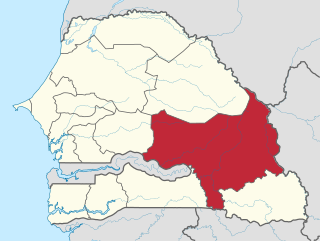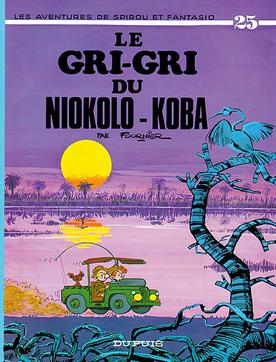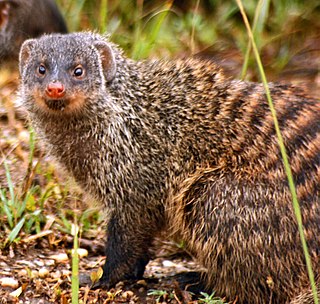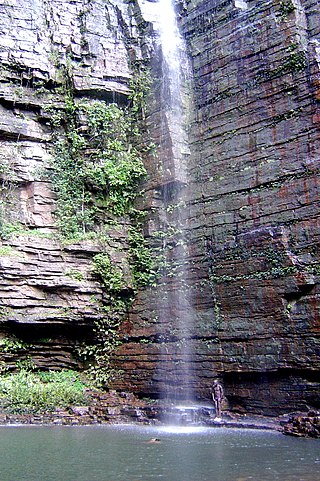
This article describes the system of transport in Senegal, both public and private.This system comprises roads, rail transport, water transport, and air transportation.

Tambacounda, formerly known as Sénégal Oriental, is a region of Senegal. It used to be part of the Mali Empire before the borders were created to separate Mali from Senegal. Tambacounda is physically the largest of Senegal's 14 regions, but is sparsely populated and its economy lags behind the rest of the country. The department of Kédougou was separated from Tambacounda in 2008, and became a separate region.

The giant eland, also known as the Lord Derby's eland and greater eland, is an open-forest and savanna antelope. A species of the family Bovidae and genus Taurotragus, it was described in 1847 by John Edward Gray. The giant eland is the largest species of antelope, with a body length ranging from 220–290 cm (7.2–9.5 ft). There are two subspecies: T. d. derbianus and T. d. gigas.

Kédougou is a town in the Kédougou Region of south-eastern Senegal near the border with Mali and Guinea. It lies at an elevation of 167 m (548 ft) above sea level.

The Niokolo-Koba National Park is a World Heritage Site and natural protected area in southeastern Senegal, near the Guinea border. It is served by Niokolo-Koba Airport, an unpaved airstrip.
Rhinoleptus koniagui, also known commonly as Villiers's blind snake, is a species of snake in the family Leptotyphlopidae. The species, which is indigenous to West Africa, is monotypic in the genus Rhinoleptus. It is among the smallest snakes in the world. There are no subspecies that are recognized as being valid.

Le gri-gri du Niokolo-Koba, written and drawn by Fournier, is the twenty-fifth album of the Spirou et Fantasio series, and the author's fifth, following the retirement from Spirou magazine of André Franquin. The story was initially serialised in Spirou, before it was released as a hardcover album in 1974.

The wildlife of Senegal consists of the flora and fauna of this nation in West Africa. Senegal has a long Atlantic coastline and a range of habitat types, with a corresponding diversity of plants and animals. Senegal has 188 species of mammals and 674 species of bird.
Basse Casamance National Park, located near Oussouye in Ziguinchor, is one of six national parks in Senegal. It is currently closed.

Dindefelo Falls, located in the town of Dindefelo, is a tourist attraction and park in southeast Senegal. It is located just a few miles from the Guinean border. The falls are about 100 meters high. The park area forms part of the larger Niokolo-Koba National Park, a UNESCO Biosphere world heritage site. UNESCO estimates the annual tourist visits to the falls is in the thousands.
Under UNESCO’s Man and the Biosphere Programme (MAB), there are 70 biosphere reserves recognized as part of the World Network of Biosphere Reserves in African states as of 2016. These are distributed across 28 countries. While biosphere reserves in West African, East African, Central African and Southern African countries are organised in the AfriMAB regional network, biosphere reserves in Northern African countries are organised in the ArabMAB, UNESCO's regional MAB network.
Segou is a village in the Kédougou Region of south-eastern Senegal at 12.41 degrees N latitude and 12.28 degrees W longitude. It is 25 km from the region capital of Kédougou and 120 km from Niokolo-Koba National Park. It is in the foothills of the Guinea mountains. It has a population of about 1,000. Nearly all of the people of the village are Pula Futa.
The African sandhopper is a species of pygmy mole cricket found throughout Africa south of the Sahara Desert. It prefers sandy or muddy open river banks. It has been recorded from Niokolo-Koba National Park in Senegal.
Badiar National Park is a national park in Guinea, on the border with Senegal and contiguous with Senegal's much larger Niokolo-Koba National Park. It was established on 30 May 1985, partly in response to Senegal's concern about poaching in Niokolo-Koba National Park. Badiar is an International Union for Conservation of Nature Category II park.
Salémata is a small town with commune status in south-east Senegal. It is the chief settlement of the Salémata Department in the Kédougou Region. It lies close to the Niokolo-Koba National Park and the Dindefelo Falls, close to the border with Guinea Conakry.

The N7 road is one of the 7 national roads of Senegal. It connects Ouro Sogui in the north-east of Senegal to Kédougou in the south-east by a route which crosses the Niokolo-Koba National Park.
Badia rugosa is species of Senegalese palp-footed spiders. It is the only species in the monotypic genus Badia. The species and genus were first described by Carl Friedrich Roewer in 1961. It is only found in Senegal.









